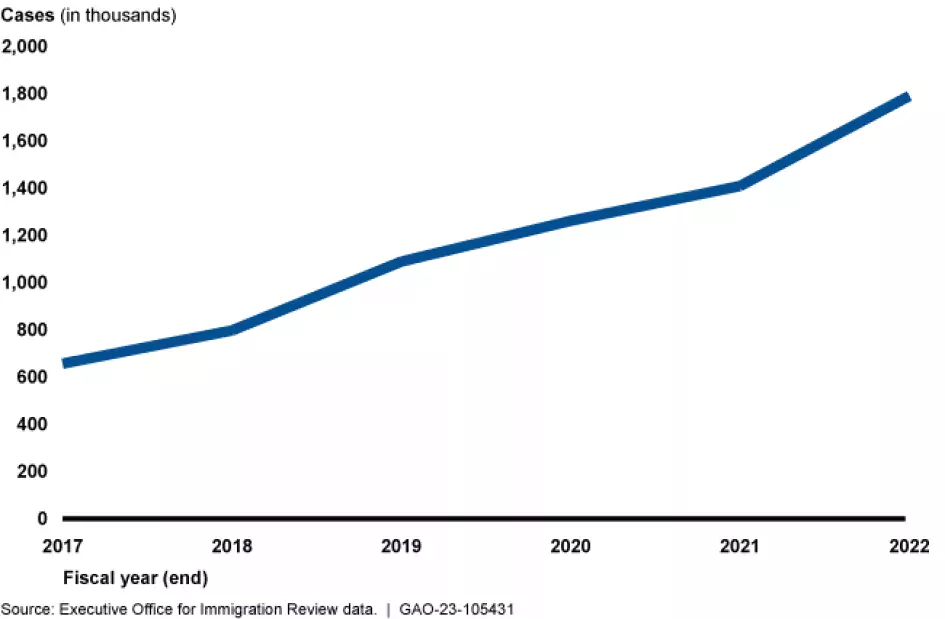U.S. Immigration Courts See a Significant and Growing Backlog
More than 2 million cases are pending in U.S. immigration courts. This backlog has more than tripled since the start of fiscal year 2017. The effects of the backlog are significant and widespread. In particular, the backlog causes delays and poses challenges for noncitizens whose cases are being heard in immigration courts, as well as attorneys and immigration judges and court staff.
Some noncitizens—including children and families—wait years to have their cases heard. The delays postpone decisions for vulnerable populations who may be eligible for protections, such as asylum. They also prolong the removal from the U.S. of those who do not have valid claims to remain. Further, these delays result in increased work for immigration judges and court staff. The Department of Justice has sought additional funding from Congress to hire more judges and court staff, but continues to face challenges in managing its workforce.
Today’s WatchBlog post looks at our work on challenges facing immigration courts, and ways to address them. Yesterday, GAO’s Rebecca Gambler, an expert on immigration, testified before Congress about our work. You can watch her testimony here.
Pending Cases in Immigration Courts, Fiscal Years 2017-2022
Image

Staffing and management challenges
More than 650 immigration judges located in 69 courts across the country hold hearings to decide if noncitizens should be removed from, or allowed to stay in, the United States. Each year, immigration judges issue decisions in cases for hundreds of thousands of noncitizens who may be removed from the country. The Department of Justice’s Executive Office for Immigration Review (EOIR) is responsible for conducting immigration proceedings, appellate reviews, and administrative hearings to fairly, expeditiously, and uniformly administer and interpret U.S. immigration laws.
In a 2017 report, we looked at EOIR’s management of the immigration court system, including how it determines its workforce needs and addresses them. We found that EOIR faces longstanding workforce management challenges and did not have a strategic workforce plan to address them. Such a plan would better position the office to identify critical skills, develop strategies to address skills gaps in its workforce, as well as monitor progress in addressing current and future staffing needs.
We recently looked at EOIR’s workforce management again, in an April 2023 report. Even though EOIR was continuing to see growing backlogs, we found that it had still not developed a strategic workforce plan or set workforce planning goals, as we had previously recommended. EOIR had taken some steps since 2017 to improve its workforce planning practices, but we found that key gaps remained. In particular, the office does not have a governance structure to guide its efforts and hold leadership accountable for making progress on workforce goals.
The last time EOIR had an agency-wide strategic plan was 2013. Without an overall strategic direction, it is difficult to create an effective workforce plan or ensure workforce planning and human capital processes will support EOIR’s organizational goals.
What more should EOIR be doing?
It is critically important for EOIR to develop and implement a strategic workforce plan, as we recommended in 2017. In our latest report, we made six new recommendations to help the office continue its efforts to address workforce and other management challenges. In addition to developing and implementing a strategic workforce plan and holding management accountable for meeting workforce goals, we recommended that EOIR take steps to clearly communicate its workforce needs to Congress. Moreover, we think it is important that the office develop a schedule and time frames for completing its agency-wide strategic plan. Having such a plan in place can help EOIR set a direction for its workforce and guide efforts for workforce planning.
To learn more about our work on immigration courts, read our latest report.
- GAO’s fact-based, nonpartisan information helps Congress and federal agencies improve government. The WatchBlog lets us contextualize GAO’s work a little more for the public. Check out more of our posts at GAO.gov/blog.





